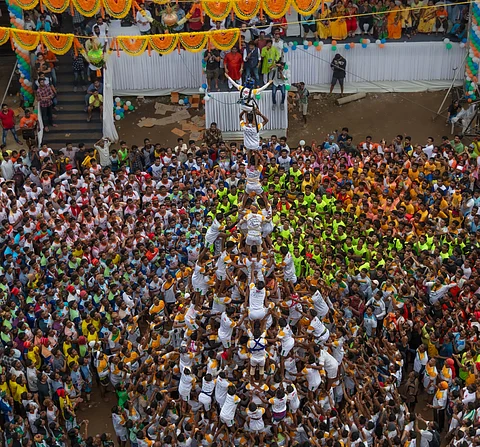
- Destinations
- Experiences
- Stay
- What's new
- Celebrating People
- Responsible Tourism
- CampaignsCampaigns
- Subscribe
- Buy Now

The festival of Janmashtami, which celebrates the birth of the Hindu deity Krishna, is a rollicking and joyous affair all across India. While different parts of the country observe their own unique traditions—the raslilas of the north, the preparation of sweets such as chakodi, murukku and seedai in the south, and fasting in the east—most of us today associate the festival with the iconic visuals of Maharashtra’s dahi handi.
Literally translated as “curd pot,” the event honours Krishna's playful and mischievous nature as a child, when he and his friends would steal butter and curd stored in pots hanging from ceilings. The dahi handi involves participants forming human pyramids to reach and break a handi (pot) suspended high above the ground. This celebration does not simply require physical strength but symbolises teamwork, perseverance, devotion and unity.
The dahi handi festival is marked by vibrant processions, traditional music and the enthusiastic participation of teams called govinda pathaks. There are several stages to the event, which include:
The Preparation And Decoration: A clay pot filled with curd, butter and other items like fruits and coins is tied high above the ground, often between two buildings or on a tall pole. The area is decorated with colourful banners, flowers and lights to create a festive atmosphere.
The Formation Of Human Pyramids: The govinda pathaks form human pyramids of nearly nine tiers to reach and break the handi. The task requires immense physical strength, balance and coordination, as the clay pot is often suspended at a challenging height. The lowest layers consist of the most people, while the middle layer players needing to pay attention to those below as well as those standing on their shoulders. At the topmost layer is a lightweight and nimble participant who will attempt to break the handi. In 2012, the Jai Jawan Govinda Pathak team from Jogeshwari, Mumbai, entered the Guinness World Records by forming a human pyramid of nine tiers that was 13.35 m high at an event in Thane.
Cheering The Participants: Spectators gather in large numbers to cheer for the govinda pathaks, creating a lively and energetic environment. There is traditional music, dhol (drum) beats and the chanting of slogans like “Govinda aala re” which add to the excitement.
Breaking The Handi: Once the pyramid is successfully formed, the topmost participant breaks the handi, spilling its contents as a symbol of victory and joy.
Prize Distribution: Organisers often announce cash prizes or gifts for the winning teams, adding a competitive edge to the festivities. Local and state political parties are active during this event, offering their own prize money and sponsoring their own teams. In 2022, an Indian Premier League-style franchise model called the “Pro Govinda” was adopted. The Jai Jawan Govinda Pathak won the championship in 2023 and 2024.
While the dahi handi is celebrated across Maharashtra and has extended its popularity to the neighbouring states of Gujarat and Goa, the cities of Mumbai, Thane and Pune are renowned for their grand and competitive events. The activity is usually held in open spaces or prominent city locations, with organisers ensuring arrangements for safety and crowd management.
This year, the dahi handi will be celebrated on August 16. The top places to see the event in Mumbai are:
Dadar: Known for its massive crowds, competitive govinda teams and celebrity appearances, Dadar is one of the top spots to experience Janmashtami celebrations. It hosts some of the city's oldest and most spirited dahi handi events.
Vile Parle And Lower Parel: These areas are known for offering high prize money, attracting top govinda pathaks. As a result, they draw thousands of spectators who come to witness the thrilling competition.
Lalbaug: Famous for its Ganesh Chaturthi celebrations, Lalbaug also hosts a dynamic Janmashtami event, led by the Bal Gopal Mitra Mandal. It’s one of the most electrifying venues in Mumbai where you can experience the festive spirit.
Ghatkopar: In Ghatkopar, the Shri Krishna Janmashtami Utsav Mandal organises one of the grandest and challenging dahi handi events. The handi is placed at a significant height, adding to the competitive excitement.
Celebrations usually begin at 10 AM and peak around 2-5 PM.
Take the local trains to the nearest station to the dahi handi event. For last-mile travel, take cabs or autos.
Don’t stand too close to the pyramid areas.
Carry water and wear light clothes.
Avoid going into crowded zones with very young kids.
